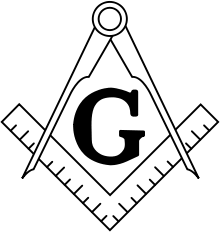Freemasonry and women
.jpg)
Freemasonry and women have a complex relationship, which can be readily divided into many phases with no demonstrable relationship to each other until the 20th century. A few women were involved in Freemasonry before the 18th century; however the first printed constitutions of the Premier Grand Lodge of England appeared to bar them from the Craft forever.
The French Lodges of Adoption which spread through Continental Europe during the second half of the 18th century admitted Masons and their female relatives to a system of degrees parallel, but unrelated to the original rite. After eclipse in the 19th century, they were revived as women-only lodges in the 20th, and these later adopted the male degrees to give rise to French women's Masonry in the 1950s.
18th-century British lodges and their American offshoots remained male only. In the late 1800s, rites similar to adoption emerged in the United States, allowing masons and their female relatives to participate in ritual together. These bodies, however, were more careful to discriminate between the mixed ritual and the genuine Freemasonry of the men.
In the 1890s, mixed lodges following a standard Masonic ritual started to appear in France, and quickly spread to other countries. Women-only jurisdictions appeared soon afterwards. As a general rule, the admission of women is now recognised in Continental (Grand Orient) jurisdictions. In Anglo-American Freemasonry, neither mixed nor all-female lodges are officially recognised, although unofficial relations can be cordial, with premises sometimes shared.
Women as Operative Masons
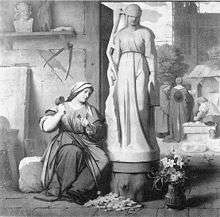
Women in Mediaeval and Renaissance Europe were legally assumed to be subject to their fathers, then to their husbands after marriage. The status of women within Mediaeval trades was largely dependent on the local interpretation of femme sole, the legal term for a single woman. This was usually the widow of a tradesman, who was permitted to continue her husband's business after his death, and often established in the rights and privileges of his trade guild or company. More rarely, single women would achieve success in their father's trade. Exceptions occurred mainly in trades linked to traditional women's occupations, such as haberdashery and needlecraft.[1]
In Norwich, a woman called Gunnilda is listed as a mason in the Calendar for Close Rolls for 1256.[2] It is reputed that Sabina von Steinbach, the daughter of the Architect, worked on Strasbourg Cathedral in the early part of the 14th century, although the first reference to her work comes 300 years later. In England, hints of female participation appear in the Regius Manuscript (ca 1390-1425), and in the Guild records at York Minster in 1408. Women were employed in administrative roles in the London Mason's Company, and as such received the benefits of membership. Also, the charge in York Manuscript No 4, dated 1693 and used as a warrant by the later Grand Lodge of All England at York, contains the phrase "hee or shee that is to be made mason". While a number of masonic historians have categorised this as a "misprint", Adolphus Frederick Alexander Woodford, who studied and catalogued these documents, considered it genuine.[3]
In the sixteenth and seventeenth centuries, the status of women amongst masons in Britain is likely to be similar to that codified in the minutes of the lodge at St. Mary's Chapel in Edinburgh. A burgess could pay for the Freedom to employ and instruct masons. The widow of a master mason could accept commissions from his old clients, provided that she employed a journeyman of the lodge to supervise the work.[4]
Lodges of Adoption
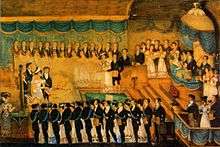
As the Freemasonry of the Premier Grand Lodge of England spread in France, the French fraternity stayed within the letter of Anderson's proscription of women, but saw no reason to ban them from their banquets or their religious services. During the 1740s, lodges of adoption began to appear. Attached to a regular (men only) lodge, wives and female relatives of the masons would be admitted to a parallel system of degrees, with a similar moral undertone to the authentic rite of the lodge. The earliest had a nautical theme. In 1747, the Chevalier Beauchaine began the Order of Woodcutters (Ordre des Fendeurs), with rites supposedly based on an early version of the Carbonari. In 1774, the lodges of adoption came under the jurisdiction of the Grand Orient de France, and the published regulations show a system of four degrees:[5]
- Apprentie, or Female Apprentice.
- Compagnonne, or Journeywoman.
- Maîtresse, or Mistress.
- Parfaite Maçonne, or Perfect Masoness.
Further degrees came and went, with a ten-degree system evolving at the end of the Eighteenth century. The idea spread widely in Europe, but never appeared in England. After a brief eclipse during the Reign of Terror at the start of the French Revolution, lodges of adoption flourished, with the Empress Josephine presiding over one in Strasbourg in 1805.[5]
In 1808, the Grand Orient decided that these lodges were unconstitutional, and they became marginalised until re-activated by the same Grand Orient in 1901. In their new incarnation, the chair was taken by a woman, where previously only a man could occupy the "Chair of King Solomon".[6] Final separation occurred in 1935, and in 1959 they adopted the Ancient and Accepted Scottish Rite, embracing regular masonry as Grande Loge féminine de France. Only one lodge, Cosmos, holds to the adoptive rite.[7][8]
Other concordant bodies admitting women
Concordant rites exist with the blessing and often the active support of regular masonic lodges. There are several concordant bodies in the United States which admit the wives and female relatives of Freemasons. The Dutch Order of Weavers admits only the wives, while in the American orders the men and women share in the ritual. Like the lodges of adoption, they have their own ceremonies, which means that some grand lodges view them as irregular.[9]
- Order of the Eastern Star In 1850, Rob Morris created the Order of the Eastern Star for Freemasons and their female relatives. Often classed as an adoptive rite, its ritual is based on the Bible. It continues to flourish in the United States of America,[10] and maintains a presence in Scotland.[11]
- Order of the Amaranth The ritual of the Order of the Amaranth was conceived in 1860 to be loosely based on a society with a similar name instituted over two centuries earlier by Queen Christina of Sweden. Open to master masons and their female relatives, members were once compelled to join the Order of the Eastern Star first, but the two organisations became separate in 1921.[12]
- Ladies’ Oriental Shrine of North America Founded in 1903 in Wheeling, West Virginia, the order has over 16,000 members in 76 Courts across North America. A woman must be related to a member of the Ancient Arabic Order of the Nobles of the Mystic Shrine or a Master Mason by birth, marriage or adoption. She must be at least 18 years of age and a resident for at least six months in the area of the Court in which membership is desired.[13]
- The Order of the White Shrine of Jerusalem Like the members of the Masonic Lodge and other appendant bodies, members of the White Shrine must profess a belief in a Supreme Being. However, the White Shrine goes one step further, requiring members to profess a belief in Jesus Christ as the Savior and Redeemer of the World. Membership is open to female relatives of Master Masons or members either active for three years or majority of the International Order of Rainbow for Girls or Job's Daughters International who have attained of eighteen (18) years of age.[14]
- Heroines of Jericho, Order of Cyrenes Offshoots of Prince Hall Freemasonry, these two orders are open to Royal Arch and Templar masons respectively, together with their female relatives.[15][16]
- Order of Weavers Formed on 17 July 1947, the Orde van Weefsters Vita Feminea Textura, or the Order of Weavers was the creation of the wives of Dutch Freemasons. They constructed a ritual system using the tools of weaving in their symbology, which they judged to be more appropriate for women than stonemasons tools. There are now 17 lodges spread through the Netherlands.[17]
Quasi-Masonic Rites
Many rites accepting women have ritual of a Masonic style, are founded by Masons, but at best have an ambivalent reception amongst Grand Lodge masons. Nonetheless, they actively recruit new members from within regular masonry.
- The Order of the Pug The Order of the Pug, or Mops-Orden, is believed to have been founded in Bavaria in about 1740, to circumvent the Papal ban on Catholics becoming Freemasons. Admitting both men and women, the order had a single rite, based on the faithfulness of the pug dog.[18][19]
- Cagliostro's Egyptian Rite In 1784, in Bordeaux, the man calling himself Count Alessandro di Cagliostro opened the first lodge of his Egyptian Rite masonry. This had the three degrees of normal French masonry (Apprentice, Companion and Master), but with a greatly different, more mystical ritual. Cagliostro claimed that he was re-introducing true Freemasonry, and he attempted to attract candidates wherever he went. Male candidates were already Freemasons, but women were also admitted. The ceremony for the two sexes differed only in minor points - males were admitted by Cagliostro (the Grand Copht) and females by his wife (the Queen of Sheba). On admission, the women were told that they were now Freemasons.[20]
- Rite of Memphis-Misraïm Proceeding from Cagliostro's rite, the Rite of Misraïm (from Arabic مصر Miṣr = Egypt) continued as a form of mixed, esoteric masonry. Banned in 1817, it was reformulated as the Rite of Memphis in 1838, and in spite of fluctuating fortunes in its French home, began to spread internationally during the second half of the nineteenth century. During the 1880s the two rites were fused by Giuseppe Garibaldi into the Rite of Memphis-Misraïm.[21] The modern order now boasts up to 99 degrees, not all of which actually worked.[22]
- The Hermetic Order of the Golden Dawn The membership and ritual of the Hermetic Order of the Golden Dawn were strongly linked to Freemasonry, but membership was open to non-masons and to women. The grades formed a teaching system for the Caballah, and initiates had to pass an exam before being allowed to advance to the next degree.[23]
Female Masons in "Masculine Only" Masonic Bodies
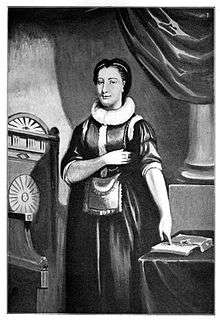
There have been a few reported cases of a woman joining a "masculine only" masonic lodge. These cases are exceptions and are debated by masonic historians.
Elizabeth Aldworth
One account of a woman being admitted to Freemasonry in the 18th century is the case of Elizabeth Aldworth (born St Leger), who is reported to have surreptitiously viewed the proceedings of a Lodge meeting held at Doneraile House, the private house of her father, first Viscount Doneraile, a resident of Doneraile, County Cork, Ireland. Upon discovering the breach of their secrecy, the Lodge resolved to admit and obligate her, and thereafter she proudly appeared in public in Masonic clothing. Speculative attempts to link the lodge of her initiation with a documented lodge of the Grand Lodge of Ireland have proved futile, but there is no reason that her father should not have instituted a lodge in his home, and the authenticity of her initiation is generally accepted.[24][25]
Madame de Xaintrailles
The story runs that this woman dressed as a man to enlist in the French Army, and attained the rank of Captain of Cavalry. Since the Army treated her as a man, the Lodge of Freres-Artistes in Paris voted to initiate her, knowing she was a woman, when she presented herself in her cavalry uniform, with her paperwork as an Aide-de-camp. She is said to have been the wife of "General de Xaintrailles", probably Charles Antoine Dominique Xaintrailles.[26][27]
Countess Helene/Ilona Hadik-Barkóczy de Szala
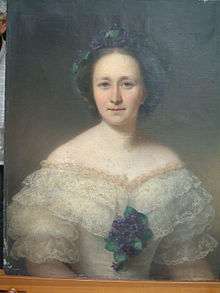
Countess Barkóczy (1833 - 1887) became fascinated by her grand-uncle's books on Freemasonry, browsing through his library after his death. By this time, she was married to Count Bela Hadik, Emperor Maximilian's aide-de-camp. The Countess' request for initiation into a Masonic lodge was supported by the Johannite Grand Master Ferenc Pulszky, and she was duly initiated in 1875 by a provincial lodge of Grand Orient, Lodge Egyenlőség (Equality) in Unghvár. (In Hungary in that time there were two masonic Grand Lodges, the Grand Lodge of St. John and the Grand Orient worked independently from each other.) Her initiation was then declared void by decision of Grand Orient and the perpetrators were punished, but the lodge wasn't erased, and only one officer was excluded. The countess defended her request and argued its validity in common law. In her reasoning she brought up her knowledge of freemasonry, her legal status as a son (praefectio) and the absence of any mention of candidates' gender in the constitution of the Grand Orient. The Orient, holding to Prussian law, considered the initiation null and void because the usual bureaucratic formalities were not adhered to.[28] The next year, after debating her status, the Grand Orient demanded the return of her certificate, but she never complied. Masonic sources repeat Denslow and Truman (10,000 masons) giving her name as Countess Helene Hadik Barkóczy, while biographical and family sources use the Hungarian name Ilona.[29][30]
Salome Anderson
In 1892, American newspapers hailed Salome Anderson, of Oakland, California as "the only female Freemason in the world". She had, according to some, learned the secrets of masonry by hiding in the lodge room in her uncle's house, and was made a mason in order to pledge her to secrecy. She served on the board of trustees of her temple, and took higher degrees, as well as joining the Order of the Eastern Star.[31]
The theme of a young woman hiding in a lodge room had become a standard formula for this type of report, which was uncritically echoed and embellished as it spread from newspaper to newspaper. Anderson herself denied that it was possible for a woman to be made a mason, but remained non-committal or downright enigmatic when questioned as to the origin of her extensive knowledge of Freemasonry. Born in Alsace in 1818, she was raised in Paris after her parents died by her uncle, a "prominent mason". She met and married Captain Andrew Anderson in the 1840s, and settled in New Orleans, accompanying her husband on his coastal voyages in their own vessel, and managing their finances. They moved to Oakland, California in 1854, where Andrew became a respected businessman and an active mason. He died in 1867, leaving Salome a wealthy widow, who turned her fortune to helping masonic charities. She became the founding treasurer of Oak Leaf Chapter No 8 of the Order of the Eastern Star, and when a Masonic Temple was built, she became the largest stock-holder. In spite of opposition, she was elected to the board of trustees. In 1892, the Trestle Board published a biography of her as a prominent citizen and implied that she had acquired some degree of masonic knowledge from the masons meeting at the house of her uncle. The San Francisco News-Letter and Advertiser then embellished the story by saying that she "claimed to be a mason", having cajoled the younger members of her uncle's lodge into clandestinely conferring the three Blue Lodge degrees on her. This story was rapidly picked up by the West Coast press, and various versions of the story were passed around. While she strenuously denied that she had come by her knowledge in an improper way, in subsequent interviews she refused to be drawn on the source of her masonic knowledge. It not known if she was ever initiated.[32][33]
Catherine Babington
A similar story was published about Catherine Babington, first in her obituary, in Shelby, North Carolina, in 1886, then in a short book by her son outlining her masonic career. Hailed as the only female mason in the United States, she is said to have obtained the secrets at the age of 16 by hiding in her uncles' lodge room in Princess, Kentucky. Having lost her father at an early age, she spent much of her childhood at her grandfather's house, where she became a favourite of her uncles. They attended a lodge in an unused chapel above Catherine's school-room, which she often helped them clean. As a teenager, Catherine Sweet (Babington being her married name) attended lodge meetings for a year, hiding in the old pulpit, finally being discovered when one of her uncles returned unexpectedly for a rifle he had left in the ante-room. Being questioned by the lodge, it was discovered that she had committed much of the ritual to memory, and was, like Anderson, made a mason to swear her to secrecy, but in this instance not admitted to membership of the lodge. The sole source of the story is her son, and much of the detail remains unconfirmed. There is no account or recollection of such a lodge room in or around Princess.[34][35]
Co-Freemasonry: Freemasonry for Men and Women
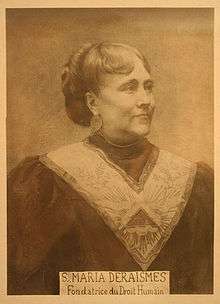
On 14 January 1882, Maria Deraismes was initiated into Freemasonry in Loge Libre Penseurs (Freethinkers Lodge), in Le Pecq, just outside Paris. Deraismes was a well known writer and campaigner for democracy, women's rights, and the separation of church and state. Her lodge, on 9 January, had seceded from la Grande Loge Symbolique Ecossaise in order to initiate her. She then resigned, to enable her lodge to rejoin their previous jurisdiction. She did, however, persist in her efforts to legitimately become a mason, with the assistance of Doctor Georges Martin, a fellow campaigner for women's rights, and a Freemason. After a decade of trying they started to form their own lodge, and between 1 June 1892 and 4 March 1893, assembled 16 women who wished to become masons. They were initiated as Apprentices on 14 March 1893, Companions on 24 March, and Master Masons on 1 April. This done, on 4 April the now mixed lodge of male and female masons proceeded to elect its officers and constitute itself as La Grande Loge Symbolique Ecossaise de France, Le Droit Humain, soon to become l’Ordre Maçonnique Mixte International Le Droit Humain. This would flourish as international co-masonry, which Deraismes never lived to see. She died the following February.[36][37]
Having resolved at the outset to adopt the Ancient and Accepted Scottish Rite as their ritual, the new Grand Lodge found itself with only the three craft degrees, and aspiring to a 33-degree system. Male masons were sent into other jurisdictions to acquire the necessary ritual. In 1899, ten masons in the Droit Humain received the 33rd degree, allowing them to form a Supreme Council. Lodges had opened in Paris, Blois, Lyon, Rouen, and Zürich. By 1914, the movement had spread to Britain, the Far East, the United States, Belgium, and the Netherlands.[38]
Co-Freemasonry was brought to the English-speaking world by the socialist and theosophist Annie Besant. Passing through the usual three degrees of craft masonry in 1902, she founded the Lodge of Human Duty No. 6 in London that same year. French-speaking lodges started to appear in the United States in 1903, but it was again Besant who opened the first English speaking lodge, in 1908. The French lodges took their lead from the Grand Orient de France in not requiring any religious belief in their members. Besant, with the blessing of Paris, followed the lead of the United Grand Lodge of England in requiring initiates to believe in a supreme being. Craft degrees in English speaking lodges took on a less continental, and more mystical flavour, with Besant importing the Dharma, or Besant Leadbeater ritual to both Britain and the United States.[6][39]
Modern Co-Freemasonry is divided into self-governing Federations, Jurisdictions, and pioneer lodges, bound to an International Constitution and a Supreme Council, which delegates elect at an international convention every five years. In common with any other Masonic jurisdiction, the president of the Supreme Council is referred to as the Grand Master. It currently has 28,000 members spread through 60 countries and 5 continents.[40]
Exclusive Women's Lodges
It is possible that a women's lodge existed in Boston during the last quarter of the eighteenth century. Hannah Mather Crocker, in an apology for Freemasonry written in 1815, claims to have presided over such a lodge, yet her description, "founded on the original principles of true ancient masonry, as far as was consistent with the female character" leaves the actual constitution open to question. It is also clear that St. Anne's lodge was extinct at the time of her writing about it.[41][42]
As Co-Freemasonry spread in England from 1902, some members became alarmed by decisions taken by the governing body in Paris. There was a perceived threat to the ancient form of masonic ritual. Resignations resulted, in 1908, in the formation of a new Grand Lodge, which became the Honourable Fraternity of Antient Masonry, under a clergyman, the Rev. Dr. William Frederick Cobb, as Grand Master. His retirement after four years led to the election of a female Grand Master. Reverting to the original legal meaning of Brotherhood, the members have addressed each other as Brother since 1908. A further split occurred in 1913, when those wishing to include higher degrees, specifically the Royal Arch, left to form the Honourable Fraternity of Ancient Freemasons. Both societies are now exclusively female. The Honourable Fraternity of Antient Masonry restricted initiation to women and stopped admitting male visitors. The last male member left in 1935. The older society, having started working higher degrees, changed its name in 1958, appending the Order of Women Freemasons, as they are known today. Both bodies have lodges throughout the United Kingdom, and the Order of Women Freemasons also has lodges in Australasia, Zimbabwe, and Spain.[43][44]
La Grande Loge féminine de France, which emerged from adoptive masonry in 1959, spread to Belgium in 1974, and la Grande Loge féminine de Belgique was formed in 1981. By 2001, they had 35 lodges, three of which were in the United States.[45] These arose due to La Croisee des Chemins (Crossroads), a lodge under la Grande Loge féminine de Belgique formed to spread Freemasonry amongst the women of other countries.[46]
Recognition of Women as Freemasons
The Anglo-American jurisdictions of "regular" Freemasonry follow a set of traditions referred to in ritual as the Ancient Landmarks. These comprise the practices and precepts perceived as "ancient" at the beginning of the 18th century, and frozen in time by Anderson's Constitutions and similar works which followed and copied it. Among Anderson's Ancient Charges, still enshrined in the constitutions of the United Grand Lodge of England (UGLE) and many other Grand Lodges, is a description of the person who may be admitted to Freemasonry, "good and true men, free-born, and of mature and discreet age and sound judgement, no bondmen, no women, no immoral or scandalous men, but of good report".[47] [48] For this reason, any lodge admitting women is considered irregular by mainstream lodges and Grand Lodges. Masons attending irregular lodges or subscribing to irregular jurisdictions, are subject to immediate exclusion or suspension from the craft.[49] This practice is said to follow the regulation of Mediaeval stonemasons "guilds" which, UGLE claims, never accepted women. However, the UGLE has stated since 1999 that two English women's jurisdictions (The Order of Women Freemasons and The Honourable Fraternity of Ancient Freemasons) are regular in practice except for their inclusion of women, and has indicated that, while not formally recognized, these bodies may be regarded as part of Freemasonry when describing Freemasonry in general.[50][51] In North America, neither "mainstream" Freemasonry nor Prince Hall Freemasonry accept women, but rather have associated separate bodies, some of which are mentioned above, which are "Masonic" in character, but not Masonic in their content.[52] These bodies, together with co-freemasonry, remain anathema to UGLE.[9]
Continental Freemasonry has no such problems. Le Droit Humain enjoys fraternal relations with the Grand Orient de France, the Grande Loge féminine de France, and the Grande Loge de France.[53] The Grand Orient de France, in addition to recognising women's masonry, decided in 2010 that there was no reason that its lodges should not be able to initiate women, thus adding another strand to international co-masonry.[54]
See also
Notes
- ↑ Antonia Frazer, The Weaker Vessel, Mandarin paperbacks, 1989, pp108-109
- ↑ Freemason Information gives p366 in the 1902 edition in a review of Karen Kidd, A Short(er) History of Early Women Freemasons, retrieved 19 March 2013
- ↑ Honourable Fraternity of Ancient Freemasons Women as Operative Masons, quoting from Enid L. Scott, Women in Freemasonry, 1988, retrieved 3 March 2013
- ↑ David Murray Lyon, History of the lodge of Edinburgh, Blackwood, Edinburgh, 1873, pp 121-123
- 1 2 ADOPTIVE FREEMASONRY Entry from Mackey's Lexicon of Freemasonry
- 1 2 Phoenix Masonry Barbara L. Thames, A History of Women’s Masonry, retrieved 5 March 2013
- ↑ Daniel Ligou et al, Histoire des francs-maçons en France, vol. 2, Privat, 2000, pp 149-150
- ↑ Liber Latomorum Website of French Research Lodge, La vraie maçonnerie d'adoption, retrieved 6 October 2013
- 1 2 HFAF Text of UGLE statement of 10 March 1999, retrieved 24 March 2013
- ↑ see main article Order of the Eastern Star
- ↑ OES Supreme Grand Chapter of Scotland, Chapters Under Supreme Grand Chapter of Scotland, accessed 18 January 2015
- ↑ Supreme Council of the Order of the Amaranth History, retrieved 26 March 2013
- ↑ Grand Council, Ladies' Oriental Shrine of North America, Inc Grand Council, Ladies' Oriental Shrine of North America, Inc., retrieved 5 February 2014
- ↑ The Official Website of The Order of the White Shrine of Jerusalem The Official Website of The Order of the White Shrine of Jerusalem FAQ, retrieved 5 February 2014
- ↑ Prince Hall Ohio HOJ: Our History, retrieved 26 March 2013
- ↑ PHA Ebony Angels retrieved 26 March 2013
- ↑ Orde van Weefsters Beknopte ontstaans-geschiedenis van de Orde van Weefsters (Dutch Language, Brief History of the Formation of the Order of Weavers), retrieved 5 March 2013
- ↑ Masonic Trowel Mackey's Lexicon of Freemasonry, 1844, entry for "Mopses"
- ↑ Gabriel Louis Calabre Pérau, L'ordre des Franc-Maçons trahi et le Secret des Mopses révélé, Amsterdam, 1745, pp 119 et seq
- ↑ Philippa Faulks and Robert L D Cooper, The Masonic Magician: The Life and Death of Count Cagliostro and His Egyptian Rite, Watkins, 2008
- ↑ Rite of Memphis-Misraïm History, retrieved 26 March 2013
- ↑ Four Hares Ancient & Primitive Rite of Memphis-Misraïm, retrieved 26 March 2013
- ↑ Ellic Howe, Fringe Masonry in England 1870-85, Ars Quatuor Coronatorum, vol. 85 (1972), pp. 242-295.
- ↑ The Hon. Miss St Leger and Freemasonry Ars Quatuor Coronatorum vol viii (1895) pp. 16-23, 53-6. vol. xviii (1905) pp. 46
- ↑ Irish Masonic History The Hon. Elizabeth St. Leger, "The Lady Freemason". Summary article with quotes from primary sources. Retrieved 8 October 2013
- ↑ Masonic Dictionary Entry from Mackey's Encyclopedia of Freemasonry, retrieved 21 March 2013
- ↑ Karen Kidd, Haunted Chambers: the Lives of Early Women Freemasons, Cornerstone, 2009, pp66-70
- ↑ László Vári, Hadik-Barkóczy Ilona és a szabadkőművesek (Helene Hadik-Barkóczy and the Freemasons), AETAS - Journal of history and related disciplines (3/2012), p. 49-62., online
- ↑ William R. Denslow, Harry S. Truman, 10,000 Famous Masons A to J, 1957 (reprint Kessinger 2004)
- ↑ Hadik-Barkóczy family correspondence
- ↑ Library of Congress Indian chieftain., 30 June 1892, Image 4, retrieved 21 March 2013
- ↑ Karen Kidd, Haunted Chambers: the Lives of Early Women Freemasons, Cornerstone, 2009, pp173-185
- ↑ Google Newspapers The Only Female Freemason, Canadian Statesman, 29 June 1892, retrieved 8 October 2013
- ↑ Grand Lodge of North Carolina James Heath Davis, Was Catherine (Sweet) Babington A Mason?, NOCALORE (North Carolina Lodge of Research), Volume 3-Part 3-1933, pp 75-83, retrieved 22 March 2013
- ↑ Karen Kidd, Haunted Chambers: the Lives of Early Women Freemasons, Cornerstone, 2009, pp81-105
- ↑ Droit Humain Maria Deraismes (1828 - 1894), retrieved 5 March 2013. (French Language)
- ↑ Maria Deraismes Vie maçonnique French Wikipedia, retrieved 7 March 2013
- ↑ Droit Humain Histoire du Droit Humain, retrieved 8 March 2013
- ↑ Phoenix Masonry Jeanne Heaslewood, A Brief History of the Founding of Co-Freemasonry, 1999, retrieved 8 March 2013
- ↑ Droit Humain Foreword to main web-site, retrieved 8 March 2013
- ↑ Masonic Trowel e-books H. M. Crocker, A Series of Letters on Free Masonry, John Eliot, Boston, 1815
- ↑ Master Mason.com I Kidd You Not, Hannah Mather Crocker, Freemason, The Small Town Texas Mason's E-Magazine, July 2012, retrieved 20 March 2013
- ↑ Honourable Fraternity of Ancient Freemasons Our History, mainly taken from Enid L. Scott, Women in Freemasonry, 1988 retrieved 3 March 2013
- ↑ Order of Women Freemasons History, retrieved 8 March 2013
- ↑ Women's Freemasonry - USA History, retrieved 8 March 2013
- ↑ Aletheia Lodge, Los Angeles History, retrieved 8 March 2013
- ↑ Anderson, James (1734) [1723]. Paul Royster, ed. The Constitutions of the Free-Masons (Philadelphia ed.). Philadelphia, Pennsylvania: Benjamin Franklin. p. 49. Retrieved 2009-02-12.
The Persons admitted Members of a Lodge must be good and true Men, free-born, and of mature and discreet Age, no Bondmen, no Women, no immoral or scandalous Men, but of good Report.
- ↑ UGLE constitutions, Antient Charges, III, of Lodges
- ↑ UGLE Constitutions, rule 176
- ↑ UGLE FAQ retrieved 8 March 2013
- ↑ Honourable Fraternity of Ancient Freemasons Text of UGLE statement, retrieved 12 August 2012
- ↑ Prince Hall Grand Lodge of Missouri Prince Hall Masonry and Women, retrieved 24 March 2013
- ↑ LDH links page retrieved 24 March 2013
- ↑ L'Express News report, 3 September 2010, retrieved 24 March 2013
External links
- Le Droit Humain: Freemasonry For Men & Women, International Website www.droit-humain.org
- The Compass and Square: For Women Only (1916) by Harriet L. Montgomery Henderson (of the Women's Order of Esoteric Masonry)
